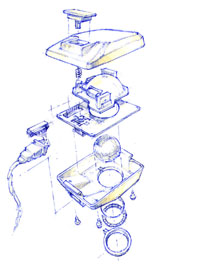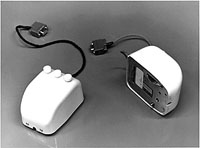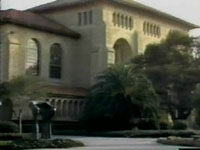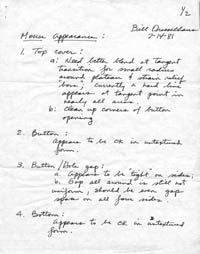
The Macintosh's mouse was one of its most notable features. It was commented upon endlessly in press coverage of the new computer; but aside from the debate over how many buttons it should have, the history of the mouse's design has received scant attention. This is a shame, for a close examination of the evolution of the Macintosh mouse has much to teach us about the history of the Macintosh, the character of technological innovation, and the process of commercializing cutting-edge technologies.
The Macintosh mouse's one-button design was its most distinctive feature. But from a technical point of view, the really important innovations were under the hood. The mouse was the creation of a group of Apple engineers and the fledgling design firm of Hovey-Kelley. Their great achievement was to take an expensive, failure-prone technology that had rarely been out of the laboratory, and turn it into a cheap, hardy, and easy-to-use product. To do this, they redesigned the mouse's mechanical and electrical systems, making it simpler, easier to manufacture, and easy to assemble. They succeeded almost too well: their design become the industry standard (even two-button mice use the same mechanical design), but it worked so well it became invisible. Unlike the graphical user interface, the mouse didn't seem to have a history; it was just there.
We can learn a lot by making the mouse visible again. For one thing, it was developed first for the Lisa, and then ported over to the Macintosh; seeing how it changed in the process can add light to the tangled history of the two computers. Understanding how the Apple mouse differed from its ARC and Xerox PARC predecessors can help us better weigh the claim that the Macintosh was inspired by a 1979 visit by Jobs and colleagues to Xerox PARC. Underlying this argument it is the belief that commercialization is technically trivial: whatever work the Macintosh team did, it couldn't have been as important as the basic research done in Douglas Engelbart's Augmentation Research Center and PARC's Computer Science Laboratory. The Apple mouse's development reveals the creativity and energy required to turn expensive prototypes into mass-produced consumer goods.

The computer mouse was invented by Doug Engelbart in the 1960s, while directing the Augmentation Research Center at the Stanford Research Institute. This design had three buttons, and used a pair of wheels (visible on the right) to translate the motion of the mouse into cursor movement on the screen. For Engelbart, the mouse was only part of a much larger technological system whose purpose was to facilitate organizational learning and online collaboration.
In the 1970s, researchers at Xerox PARC substantially redesigned the ARC mouse: in addition to changing its profile and ergonomics, the PARC mouse replaced the roller wheels with a ball, whose motion was read by a pair of metal brushes. This design was easier to use than the ARC mouse-- in particular, it now moved more smoothly than-- but both were intended for use mainly in a laboratory setting, by fairly skilled users. The mouse that Hovey-Kelley was asked to design for Apple, in contrast, had to cost a fraction of the Xerox PARC mouse, work more reliably, and be simple enough to produce, assemble, and clean easily.
All mouse-related primary documents and pictures are listed on a separate page. Two documents offer good introductions to the history of the Apple mouse. A good overview of the mouse's history and Apple's place in it can be gleaned from the Interview with Dean Hovey. Hovey, the co-founder of Hovey-Kelley Design, explains how his company came to work on the mouse; it also provides valuable perspective on the earlier work of mouse designers at Xerox PARC. Readers should then proceed to Bill Lapson's "Lore of the Mice," an essay written 8 July 1982. Lapson was the Apple project manager who oversaw (among other things) the Lisa mouse's development; his piece offers much useful information about who worked on the project, and what major challenges they faced in moving the mouse into production.
The mechanical design of the mouse is discussed in depth in the interview with Jim Yurchenco and Rickson Sun, and in a second interview with Jim Yurchenco. Yurchenco was the principal designer of the "ribcage" (shown above), which held the ball, optical encoders, and other precision parts together; Sun worked on the electrical design of the mouse.
The argument over how many buttons the mouse should have is discussed by several people involved in the mouse's development, including Dean Hovey, Jim Yurchenco and Rickson Sun, and Jef Raskin.

Several of the mouse's designers were graduates of the Stanford University Product Design Program. Dean Hovey, Jim Yurchenco, and Rickson Sun talk about how that program's distinctive culture influenced their approach.

The list of primary documents is organized chronologically, making it possible to follow the paper trail from the project's beginning to end. Thanks to the generosity of members of the Apple mouse design team, we can put online a large collection of pictures documenting the mouse's history, including drawings of mouse covers, mechanical designs, notes from user tests and brainstorming sessions; photographs of user tests, case prototypes, and the Xerox mouse; and advertisements.
The work of Douglas Engelbart is exhaustively discussed in the MouseSite, an electronic archive devoted to his work at SRI in the 1960s.